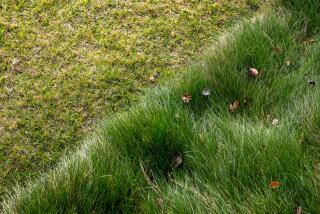August in Your Garden : FOUR BASIC BACKGROUND SHRUBS
They are simply shrubs. There is nothing colorful, unusual or spectacular about their foliage, and their flowers are basic white. But what the four shrubs pictured above do well is form a dark-green background for other plants. If the flowers in your garden lack a certain punch, it is probably because they don’t have the correct background. Roses, a flowering shrub or a bed of annual or perennial flowers will appear more dramatic against this background of deep-green foliage. Light green, gray green or reddish or “bronzy” greens won’t do. They draw attention to themselves and no longer serve as a backdrop. What we’re talking about is a simple--but substantial--green.
Not too surprisingly, several of these simple green shrubs have long been appreciated. They have been favored since Roman times for the cooling effect that their dark-green foliage brings to the sun-baked gardens of the Mediterranean--though all four shrubs can tolerate considerable shade. Although they will not grow that densely, these shrubs will grow on the north side of a house or where they’re partially shaded by a tree. The shrubs can also be pruned to shape, and they make fine hedges. All are easy to grow and are readily available. However, nursery plants are often root-bound from sitting unnoticed in a corner too long, and it is sometimes advisable to order fresh plants.
The privet of Italian Renaissance and Roman gardens was Ligustrum vulgare . More often planted in California is the Japanese privet, L. japonicum , especially the cultivar Texanum, which is a low grower (six to eight feet). Rotundifolium is another--even lower (to five feet) cultivar--and Suwannee River is lower still (to four feet).
Myrtles are another Mediterranean plant with a long history. Myrtus communis has glossy green leaves with a most pleasant scent. It grows to about six feet around and is most often seen as a hedge, though it makes a handsome, small background shrub. Cultivars such as Boetica and Compacta, smaller in size with slightly different foliage, are better as hedge plants.
Laurustinus, Viburnum tinus , also dates from Roman days. It grows to 6 or 10 feet, in time maybe even taller. In winter, the tiny, white flowers are deliciously fragrant, though subtle. In appearance it is a slightly less formal shrub.
An American native, the Carolina laurel cherry, Prunus caroliniana , is fast and exceptionally neat and regular from day one--particularly cultivars Compacta and Bright ‘n Tight. The eventual height is between 10 feet--if it’s pruned as a hedge--to 20 feet when left alone. The leaves are exceptionally shiny. This one does best away from intense heat--near the ocean or in partial shade far inland.






